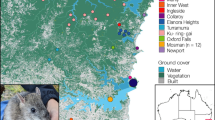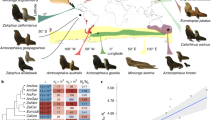Abstract
Understanding the genetic diversity of a population is important for understanding population persistence and extinction risk. The long-nosed bandicoot (Perameles nasuta) was once regarded as common throughout its range, but it is unknown whether it is at risk of decline and the genetic diversity in this species has not been assessed. We evaluated the genetic structure and diversity of a P. nasuta population from samples collected during a 6 year demographic study that encompassed a cyclical fluctuation in abundance. Genetic diversity was higher compared to other studies on bandicoot species suggesting the population is not genetically impoverished. We detected significant temporal genetic differentiation suggesting turnover of genotypes. There was no strong evidence for population structuring, indicating a panmictic population. Individual-based spatial autocorrelation analysis generated a similar pattern of relatedness across geographical distances for both sexes suggesting no or limited sex-biased dispersal. This study provides useful baseline genetic data for a large P. nasuta population that is not significantly impacted by introduced predators or habitat destruction.




Similar content being viewed by others
References
Arthur A, Catling P, Reid A (2012) Relative influence of habitat structure, species interactions and rainfall on the post-fire population dynamics of ground-dwelling vertebrates. Austral Ecol 37:958–970
Banks SC, Peakall R (2012) Genetic spatial autocorrelation can readily detect sex-biased dispersal. Mol Ecol 21:2092–2105
Banks SC et al (2015) Fine-scale refuges can buffer demographic and genetic processes against short-term climatic variation and disturbance: a 22-year case study of an arboreal marsupial. Mol Ecol 24:3831–3845
Berthier K, Galan M, Foltete J, Charbonnel N, Cosson JF (2005) Genetic structure of the cyclic fossorial water vole (Arvicola terrestris): landscape and demographic influences. Mol Ecol 14:2861–2871
Burbidge AA, McKenzie NL (1989) Patterns in the modern decline of western Australia’s vertebrate fauna: causes and conservation implications. Biol Conserv 50:143–198
Catling PC, Burt RJ, Forrester RI (2000) Models of the distribution and abundance of ground-dwelling mammals in the eucalypt forests of north-eastern New South Wales in relation to habitat variables. Wildl Res 27:639–654
Chambers LK, Dickman CR (2002) Habitat selection of the long-nosed bandicoot, Perameles nasuta (Mammalia, Peramelidae), in a patchy urban environment. Austral Ecol 27:334–342
Claridge AW, McNee A, Tanton MT, Davey SM (1991) Ecology of bandicoots in undisturbed forest adjacent to recently felled logging coupes: a case study from the Eden Woodchip Agreement Area. In: Lunney D (ed) Conservation of Australia’s Forest Fauna. Royal Zoological Society of New South Wales, Sydney, pp 331–345
Dexter N, Meek P, Moore S, Hudson M, Richardson H (2007) Population responses of small and medium sized mammals to fox control at Jervis Bay, southeastern Australia. Pacif Conserv Biol 13:283–292
Drechsler M, Eppink FV, Watzold F (2011) Does proactive biodiversity conservation save costs? Biodivers Conserv 20:1045–1055
Earl DA, Vonholdt BM (2012) STRUCTURE HARVESTER: a website and program for visualizing STRUCTURE output and implementing the Evanno method. Conserv Genet Res 4:359–361
Evanno G, Regnaut S, Goudet J (2005) Detecting the number of clusters of individuals using the software structure: a simulation study. Mol Ecol 14:2611–2620
Excoffier L, Smouse PE, Quattro JM (1992) Analysis of molecular variance inferred from metric distances among DNA haplotypes: application to human mitochondrial DNA restriction data. Genetics 131:479–491
Goudet J (2001) FSTAT, a program to estimate and terst gene diversities and fixation indices (version 2.9.3). Available from http://www.unil.ch/izea/softwares/fstat.html
Gros A, Hovestadt T, Poethke HJ (2008) Evolution of sex-biased dispersal: the role of sex-specific dispersal costs, demographic stochasticity, and inbreeding. Ecol Model 219:226–233
Hedrick P (1999) Perspective: highly variable loci and their interpretation in evolution and conservation. Evolution 53:313–318
Kearse M et al (2012) Geneious basic: an integrated and extendable desktop software platform for the organization and analysis of sequence data. Bioinformatics 28:1647–1649
Leberg PL (2002) Estimating allelic richness: effects of sample size and bottlenecks. Mol Ecol 11:2445–2449
Li Y, Lancaster ML, Carthew SM, Packer JG, Cooper SJB (2014) Delineation of conservation units in an endangered marsupial, the southern brown bandicoot (Isoodon obesulus obesulus),in South Australia/western Victoria, Australia. Aust J Zool 62:345–359
Li Y, Lancaster ML, Cooper SJB, Taylor AC, Carthew SM (2015) Population structure and gene flow in the endangered southern brown bandicoot (Isoodon obesulus obesulus) across a fragmented landscape. Conserv Genet 16:331–345
Lindenmayer DB et al (2008) Contrasting mammal responses to vegetation type and fire. Wildl Res 35:395–408
Lindenmayer DB et al (2016) Temporal trends in mammal responses to fire reveals the complex effects of fire regime attributes. Ecol Appl 26:557–573
Ozerov M, Veselov A, Lumme J, Primmer C (2013) Temporal variation of genetic composition in Atlantic salmon populations from the Western White Sea Basin: influence of anthropogenic factors? BMC Genet 14:1–15
Peakall R, Smouse PE (2006) GENALEX 6: genetic analysis in Excel. Population genetic software for teaching and research. Mol Ecol Notes 6:288–295
Peakall R, Smouse PE (2012) GenAlEx 6.5: genetic analysis in Excel. Population genetic software for teaching and research—an update. Bioinformatics 28:2537–2539
Peakall R, Ruibal M, Lindenmayer DB, Tonsor S (2003) Spatial autocorrelation analysis offers new insights into gene flow in the Australian bush rat, Rattus fuscipes. Evolution 57:1182–1195
Pereoglou F, Lindenmayer D, Macgregor C, Ford F, Banks S (2013) Landscape genetics of an early successional specialist in a disturbance-prone environment. Mol Ecol 22:1267–1281
Porras-Hurtado L, Ruiz Y, Santos C, Phillips C, Carracedo A, Lareu (2013) An overview of STRUCTURE: applications, parameter settings and supporting software. Front Genet 4:98
Pritchard JK, Stephens M, Donnelly P (2000) Inference of population structure using multilocus genotype data. Genetics 155:945–959
Raymond M, Rousset F (1995) GENEPOP (version 1.2): population genetics software for exact tests and ecumenicis. J Hered 86:248–249
Reed DH, O’Grady JJ, Brook BW, Ballou JD, Frankham R (2003) Estimates of minimum viable population sizes for vertebrates and factors influencing those estimates. Biol Conserv 113:23–34
Roberts MW, Dexter N, Meek PD, Hudson M, Buttemer WA (2006) Does baiting influence the relative composition of the diet of foxes? Wildl Res 33:481–488
Schwartz M, Luikart G, Waples R (2007) Genetic monitoring as a promising tool for conservation and management. Trends Ecol Evol 22:25–33
Scott LK, Hume ID, Dickman CR (1999) Ecology and population biology of long-nosed bandicoots (Perameles nasuta) at North Head, Sydney Harbour National Park. Wildl Res 26:805–821
Short J, Turner B, Majors C, Leone J (1997) The fluctuating abundance of endangered mammals on Bernier and Dorre Islands, Western Australia—conservation implications. Aust Mammal 20:53–71
Smith S, Hughes J (2008) Microsatellite and mitochondrial DNA variation defines island genetic reservoirs for reintroductions of an endangered Australian marsupial, Perameles bougainville. Conserv Genet 9:547–557
Smouse P, Peakall R (1999) Spatial autocorrelation analysis of individual multiallele and multilocus genetic structure. Heredity 82:561–573
Van Oosterhout C, Hutchinson WF, Willis DP, Shipley P (2004) MICRO-CHECKER: software for identifying and correcting genotyping error in microsatellites data. Mol Ecol Notes 4:535–538
Weeks AR, van Rooyen A, Mitrovski P, Heinze D, Winnard A, Miller AD (2013) A species in decline: genetic diversity and conservation of the Victorian eastern barred bandicoot, Perameles gunnii. Conserv Genet 12:1243–1254
Woinarski JCZ, Burbidge AA, Harrison PL (2015) Ongoing unraveling of a continental fauna: decline and extinction of Australian mammals since European settlement. Proc Natl Acad Sci USA 112:4531–4540
Zenger K, Johnston P (2001) Isolation and characterization of microsatellite loci in the southern brown bandicoot (Isoodon obesulus), and their applicability to other marsupial species. Mol Ecol Notes 1:149–151
Zenger KR, Eldridge MDB, Johnston PG (2005) Phylogenetics, population structure and genetic diversity of the endangered southern brown bandicoot (Isoodon obesulus) in south-eastern Australia. Conserv Genet 6:193–204
Acknowledgements
This project was supported by grants by the Australian Research Council. We thank the Wreck Bay Aboriginal Community for supporting this research. We also thank Parks Australia and Long Term Ecological Research Network for their support.
Author information
Authors and Affiliations
Corresponding author
Electronic supplementary material
Below is the link to the electronic supplementary material.
Rights and permissions
About this article
Cite this article
Piggott, M.P., Banks, S.C., MacGregor, C. et al. Population genetic patterns in an irruptive species, the long-nosed bandicoot (Perameles nasuta). Conserv Genet 19, 655–663 (2018). https://doi.org/10.1007/s10592-017-1044-5
Received:
Accepted:
Published:
Issue Date:
DOI: https://doi.org/10.1007/s10592-017-1044-5




